Mental Health Conditions & Veterans
Many veterans suffer from a variety of mental health conditions because of their experiences in service. In fact, one study found that 20% of veterans who served in Iraq or Afghanistan suffer from depression or post-traumatic stress disorder (PTSD). Moreover, 19.5% have experienced a traumatic brain injury. While it is a common understanding that veterans often suffer from mental health conditions, it is regularly presumed that they all suffer from PTSD. Part of this misunderstanding is that many mental health conditions have overlapping symptoms. So how does the VA rate mental health conditions? How does the VA handle overlapping symptoms? How do I ensure I get the rating I deserve? We will provide some clarity below.
How are mental health conditions rated?
The VA uses the same rating chart to determine a veteran’s rating percentage for all mental health conditions. The ratings are based on the severity of a veteran’s social and occupational impairment. For details regarding what symptoms equate to what rating, please see the chart in the previous blog “Four tips on how to get the highest PTSD rating.”
Overlapping symptoms across conditions and the VA
PTSD, anxiety, panic disorders, and depressive disorders all have some overlapping symptomology. This overlap can cause some confusion and misdiagnosis for veterans, doctors, and the VA. Because many mental health conditions share symptoms, the VA considers the combined effects of the conditions to determine the overall level of social and occupational impairment. Meaning, irrelevant of the name of the mental health condition that you claimed, the VA processes it for any condition. (In the attempt to get you the correct rating)
Individual Unemployability
However, as you know, the VA does not always get it right the first time. If you get back a rating that does not support you, ask yourself if you’re able to work. The VA created Individual Unemployability (IU) because even if the veteran does not have a 100% combined rating, some service-connected conditions make it impossible to hold a job. If you (1) cannot work because of your service-connected mental health condition, and (2) either have one rating at least 60%, or two or more conditions with at least one of those conditions 40% equaling at least 70% overall you may be eligible.
Veterans Help Group has been helping veterans get the rating they deserve since 1995. If you have a mental health condition and would like help with your claim, please call at 855-855-8992 or chat with us online for a free consultation.

How to Apply for VA Disability Compensation
It's one thing to know how to apply for VA disability compensation. It's another to understand the...

What is the VA DBQ?
What is the VA DBQ? A VA Disability Benefits Questionnaire (DBQ) is a form used to convey...

Most Commonly Approved VA Disability Claims
Most Commonly Approved VA Disability Claims Veterans receive VA disability benefits for a wide...





